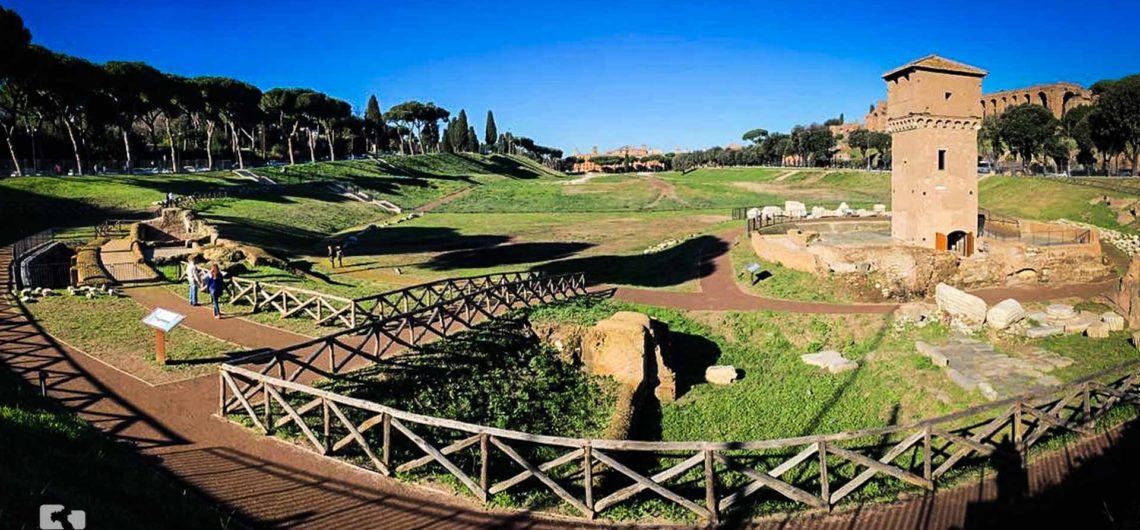Want to experience Rome from a different point of view and keep you kids engaged? Are you ready to relive the ancient splendours of the Circus Maximus in Rome during the Imperial Age through a stunning virtual experience?
A place of entertainment and an incomparable landmark, the Circus Maximus comes back to life thanks to an innovative project based on augmented (AR) and virtual reality (VR) that will grant visitors to see the building in its maximum magnificence.
The Circo Massimo Experience will finally enable visitors to see life as it was in those days with all the people strolling around the stands of food, yelling at the chariots during a race. The experience is set in a 40-minute walking itinerary divided in eight stops: the ancient valley and the origins of the Circus, the Circus from Julius Caesar to Trajan, the Circus in the Imperial Age, the Cavea, the Arch of Titus, the Botteghe (tabernae), the Circus in the Medieval and Modern Age and finally “One day at the Circus”.
Table of Contents
THE VALLEY AND THE ORIGINS OF THE CIRCUS
The immersive experience begins with the presentation of the Valle Murcia located between the Palatine and Aventine hills. In the early days, the valley was a meeting place for the different populations that inhabited the area, as well as it was a home to several religious cults.
THE CIRCUS FROM JULIUS CAESAR TO TRAJAN
The journey continues with the transformations of the Circus from the first century BC to the first century AD. The early works were set under Julius Caesar and Augustus, who conceived the Circus as a monumental structure separated from the other buildings of the Valley. Internally it was divided into three sectors: the lower one in masonry and the other two in wood. The presence of wooden seats was often cause of devastating fires, such as that of 64 AD which originated from one of the shops in the Circus. At the beginning of the first century, the Emperor Trajan rebuilt the building entirely in masonry. The structures that are still visible today belong to that phase.
THE CIRCUS IN THE IMPERIAL AGE
The Circus Maximus reached the peak of its splendour in the imperial age. The building enriched with various elements belonging to religious and mystical worlds, linked to the agricultural festivities of the origins and the cycle of the seasons. In addition to the chariot races, which were the most important and most frequent events taking place in the Circus, it was also possible to watch other types of shows, such as the hunting with exotic animals.
THE CAVEA
The Circus presented on one side the Càrceres (the starting stalls of the wagons), while the other three sides constituted the Càvea, the tiers. Spectators took place in different sectors depending on their social class. With its articulated structure, the Circus was certainly a unique monument of its kind, an immense scenic building created to amaze people from all over the Empire.
THE ARCH OF TITUS
The imposing Arco, dedicated in 81 AD by the Senate and the Roman people to the Emperor Flavius to celebrate his conquest of Jerusalem in 70 AD, will be visible in all its ancient splendour. A triumphal procession in honour of the generals and the victorious Emperor was set: it started from Campo Marzio, entered the parade in the Circus Maximus and, passing under the Arch, headed for the temple of Giove Capitolino, on the Capitoline Hill. Symbol of triumph and victory, about 20 meters high and with three arches, the Arch was surmounted by a large bronze quadriga led by the Emperor himself.
THE WORKSHOPS (TABERNAE)
In the outer belt of the Circus there were several shops called tabernae, very popular inns indeed.
THE CIRCUS IN THE MEDIEVAL AND MODERN AGE
The penultimate stage of the journey will allow visitors to immerse themselves in the transformations that interested the area of the Circus Maximus from the Middle Ages to the first half of the twentieth century. The last races in the Circus took place in the first half of the 6th century AD, then the area was filled with sediments and from the 8th century it was crossed by several waterways. The construction of the Torre della Moletta, a medieval defensive building, dates back to the 12th century. In the 1600s, the Aventine hill housed the Jewish Cemetery whose cypresses, still today, indicate its ancient location.
In 1854, the Anglo-Roman Gas Lighting Company built the first gas production plant for public lighting. The factory occupied about two thirds of the area. In the first decades of the 1900s, the Gazometers were transferred and the entire area was reclaimed: between 1928 and 1936, some sectors of the ancient Circus were dug and partly restored, but the presence of groundwater did not allow the completion of the works.
In 1936, the area of the Circus Maximus was granted to the National Fascist Party, which began to use it as an exhibition space, building impressive pavilions and also creating a real bathhouse consisting of three swimming pools dismantled in 1940 due to the beginning of the Second World War.
A unique experience for the whole family that should not be missed!
INFO
CIRCO MASSIMO EXPERIENCE
23TH MAY – 31ST DECEMBER 2019
CIRCO MASSIMO – VIALE AVENTINO (ROME)
Opening hours
From Tuesday through Sunday, from 9.30 am to 7 pm (Apr/Oct) – 9.30am to 4.30pm (Nov/Mar)
24th and 31st December: 9.30 a.m. – 2.00 p.m.
Last admission: one hour before closing time.
Closed every Mondays, 25th December, 1st January, 1st May
For further info please visit the official website of the event

Comments